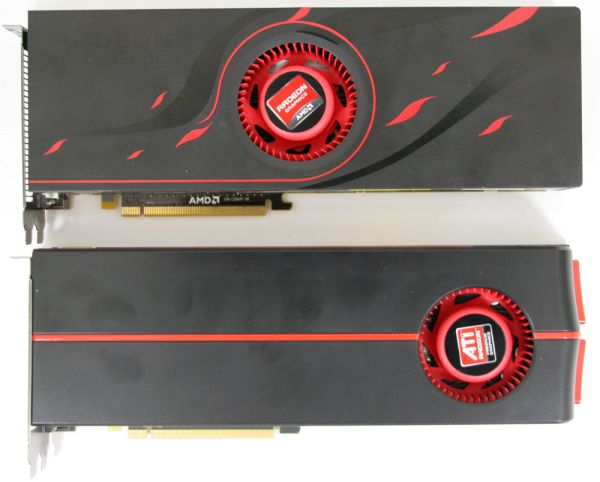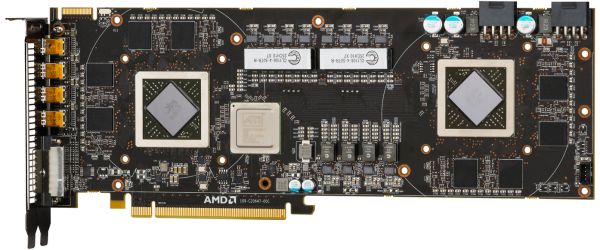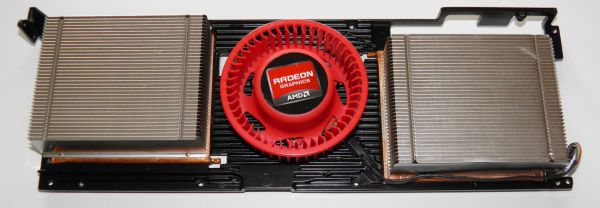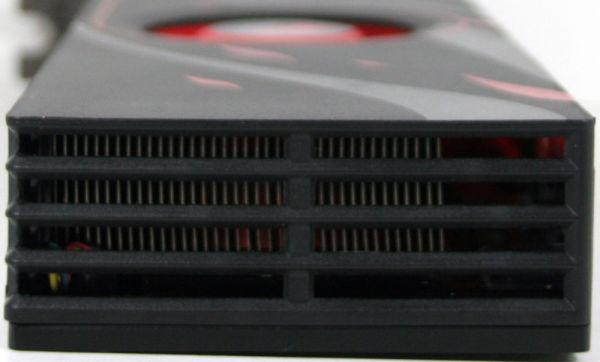AMD's Radeon HD 6990: The New Single Card King
by Ryan Smith on March 8, 2011 12:01 AM EST- Posted in
- AMD
- Radeon HD 6990
- GPUs
Meet The 6990
If you recall our coverage on the 5970, we found a few areas where AMD was lacking. The cooling on the 5970 was sufficient to run the GPUs even at 5870 clocks and voltages, however the cooling on the VRMs was lacking, leading to real world programs trigging the VRM thermal protection mechanism; and while this was within safety guidelines, it’s not a comfortable place to be for long term operation. This ultimately led to us writing off the 5970OC as a 100% reliable product, sticking to recommending the 5970 solely at stock speeds.
The design of the 6990 in turn reads very much like a response to our findings in true engineering fashion. Furthermore for the 6990 AMD not only had to take a look at the 5970’s weaknesses, but also how to handle an even greater power load. The result is that the 6990 is distinctly different from the 5970 before it.
Compared to the 5970, the 6990 is ever so slightly shorter, thanks in large part to the fact than the 6000 series casing is more squared off compared to the 5000 series’ tapered design. As a result it comes in at 11.5” for the PCB (the same as the 5970), and with casing a full 12” long compared to the 5970’s 12.16”. This means that the 6990 has effectively the same space requirements as the 5970, cooling notwithstanding.
Meanwhile it’s the fan however that is going to catch the most attention and this is where we’re going to dovetail in to cooling. The 5970’s traditional blower had its strengths and weaknesses, the strengths being that blowers are relatively forgiving about a case’s ability to exhaust hot air, and the weaknesses being that the GPU (and VRMs) closest to the fan received better cooling than the farther GPU. The VRMs proved to be particularly problematic, as they could overheat well before the GPUs did and AMD does not spin up their fans based on VRM temperatures.
Correcting for this and at the same time allowing for even greater heat dissipation, the rear blower design is out. Its replacement is a design that we’ve seen in 3rd party cards before such as the Asus ARES 5870X2, but not in a reference design: a center-mounted fan/blower with a GPU to each side. The difference is critical and indeed cannot be understated: a rear blower channels most hot air outside of the case, while a center-mounted blower effectively splits the card in two, with one GPU + supporting chips being exhausted outside of the case, and the 2nd GPU + supporting chips being exhausted inside the case. The design is still enclosed, so everything goes out either the front or back of the card while fresh air is pulled in the center.
With the replacement of the blower, so has gone the heatsink. The 5970’s single large vapor chamber + heatsink design has been replaced in favor of a segmented heatsink, further driving home the concept that the 6990 is closer to 2 video cards sharing 1PCB than it is 2 GPUs on one card. Each heatsink in turn is connected to the GPU via its own vapor chamber, resulting in the GPUs being fully isolated from each other as far as cooling is concerned.
Even the thermal paste connecting the GPUs to the vapor chambers has been changed for the 6990 – AMD has replaced traditional paste with a phase change material. Phase change materials – pastes/pads of material that melt and solidify based on temperature are nothing new, however they’re still exotic; material similar to what AMD is using is not readily available as paste is. AMD even went so far as to suggest that reviewers not directly disassemble their 6990s as it would require a new application of phase change paste in order to achieve the same efficiency as the original material. The net result of all of this by AMD’s numbers is that the phase change material is 8% better than the regular paste they’ve been using.
Rounding out our focus on cooling is the VRMs, which have been relocated in order to correct for the 5970’s limited VRM cooling capabilities. The VRMs and controllers are now at the center of the board – now they’re cooled before the GPUs or RAM modules are. The profoundness of this is twofold: not only is it an improvement on the 5970, but with the 6990’s higher power consumption VRM cooling is even more important. As with the 6970, voltage regulation is supplied by Volterra MOSFETs and controllers.
All told, while the 5970 was designed to handle and dissipate 400W of heat, the 6990 is officially designed for 450W. In practice, at its limits in our test rig this is closer to 500W. To handle and dissipate that much heat in roughly 72in3 of space is nothing short of amazing.


















130 Comments
View All Comments
Spazweasel - Tuesday, March 8, 2011 - link
I've always viewed single-card dual-GPU cards as more of a packaging stunt than a product.They invariably are clocked a little lower than the single-GPU cards they re based upon, and short of a liquid cooling system are extremely noisy (unavoidable when you have twice as much heat that has to be dissipated by the same sized cooler as the single-GPU card). They also tend to not be a bargain price-wise; compare a dual-GPU card versus two of the single-GPU cards with the same GPU.
Personally, I would much rather have discrete GPUs and be able to cool them without the noise. I'll spend a little more for a full-sized case and a motherboard with the necessary layout (two slots between PCI-16x slots) rather than deal with the compromises of the extra-dense packaging. If someone else needs quad SLI or quad Crossfire, well, fine... to each their own. But if dual GPUs is the goal, I truly don't see any advantage of a dual-GPU card over dual single-GPU cards, and plenty of disadvantages.
Like I said... more of a stunt than a product. Cool that it exists, but less useful than advertised except for extremely narrow niches.
mino - Tuesday, March 8, 2011 - link
Even -2- years since the release of the original Crysis, “but can it run Crysis?” is still an important question, and for -3.5- years the answer was “no.”Umm, you sure bout both those time values?
:)
Nice review, BTW.
MrSpadge - Tuesday, March 8, 2011 - link
"With a 375W TDP the 6990 should consume less power than 2x200W 6950CF, but in practice the 6950CF setup consumes 21W less. Part of this comes down to the greater CPU load the 6990 can create by allowing for higher framerates, but this doesn’t completely explain the disparity."If it hasn't been mentioned before: guys, this is simple. The TDP for the HD6950 is just for the PowerTune limit. The "power draw under gaming" is specified at ~150 W, which is just what you'll find during gaming gaming tests.
Furthermore Cayman is run at lower voltage (1.10 V) and clocks and with less units on HD6950, so it's only natural for 2 of these to consume less power than a HD6990. Summing it up one would expect 1.10^2/1.12^2 * 800/830 * 22/24 = 85,2% the power consumption of a Cayman on HD6990.
MrS
mino - Tuesday, March 8, 2011 - link
You shall not hit them so hard next time. :)Numbers tend to hurt one's ego badly if properly thrown.
geok1ng - Tuesday, March 8, 2011 - link
The article points that the 6990 runs much closer to 6950CF than 6970CF.I assume that the author is talking about 2GB 6950, that can be shader unlocked, in a process much safer than flashing the card with a 6970 BIOS.
It would be interesting to see CF numbers for unlocked 6950s.
As it stands the 6990 is not a great product: it requires an expensive PSU, a big case full of fans, at price ponit higher than similar CF setups.
Considering that there are ZERO enthuasiast mobos thah wont accept CF, the 6990 becomes a very hard sell.
Even more troubling is the lack of a DL-DVI adapter in the bundle, scaring way 30" owners, precisely the group of buyers most interested in this video card.
Why should a 30" step away from a 580m or SLI 580s, if the 6990 the same expensive PSU, the same BIG case full of fans and a DL-DVI adapter costs more than teh price gap to a SLI mobo?
Thanny - Tuesday, March 8, 2011 - link
This card looks very much like the XFX 4GB 5970 card. The GPU position and cooling setup is identical.I'd be very interested to see a performance comparison with that card, which operates at 5870 clock speeds and has the same amount of graphics memory (which is not "frame buffer", for those who keep misusing that term).
JumpingJack - Wednesday, March 9, 2011 - link
:) Yep, I wished they would actually make it right.
The frame buffer is the amount of memory to store the pixel and color depth info for a renderable frame of data, whereas graphics memory (or VRAM) is the total memory available for the card which consequently holds the frame buffer, command buffer, textures, etc etc. The frame buffer is just a small portion of the VRAM set aside and is the output target for the GPU. The frame buffer size is the same for every modern video card on the planet at fixed (same) resolution. I.e. a 1900x1200 res with 32 bit color depth has a frame buffer of ~9.2 MB (1900x1200x32 / 8), if double or tripled buffered, multiply by 2 or 3.
Most every techno site misapplies the term "frame buffer", Anandtech, PCPer (big abuser), Techreport ... most everyone.
Hrel - Wednesday, March 9, 2011 - link
Anyone wanting to play at resolutions above 1080p should just buy two GTX560's for 500 bucks. Why waste the extra 200? There's no such thing as future proofing at these levels.wellortech - Wednesday, March 9, 2011 - link
If the 560s are as noisy as the 570, I think I would rather try a pair of 6950s.HangFire - Wednesday, March 9, 2011 - link
And you can't even bring yourself to mention Linux (non) support?You do realize there are high end Linux workstation users, with CAD, custom software, and OpenCL development projects that need this information?